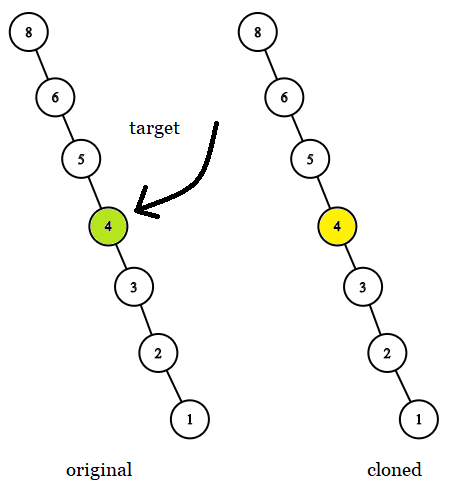| comments | difficulty | edit_url | tags | ||||
|---|---|---|---|---|---|---|---|
true |
Easy |
|
Given two binary trees original and cloned and given a reference to a node target in the original tree.
The cloned tree is a copy of the original tree.
Return a reference to the same node in the cloned tree.
Note that you are not allowed to change any of the two trees or the target node and the answer must be a reference to a node in the cloned tree.
Example 1:
Input: tree = [7,4,3,null,null,6,19], target = 3 Output: 3 Explanation: In all examples the original and cloned trees are shown. The target node is a green node from the original tree. The answer is the yellow node from the cloned tree.
Example 2:
Input: tree = [7], target = 7 Output: 7
Example 3:
Input: tree = [8,null,6,null,5,null,4,null,3,null,2,null,1], target = 4 Output: 4
Constraints:
- The number of nodes in the
treeis in the range[1, 104]. - The values of the nodes of the
treeare unique. targetnode is a node from theoriginaltree and is notnull.
Follow up: Could you solve the problem if repeated values on the tree are allowed?
We design a function
The time complexity is
# Definition for a binary tree node.
# class TreeNode:
# def __init__(self, x):
# self.val = x
# self.left = None
# self.right = None
class Solution:
def getTargetCopy(
self, original: TreeNode, cloned: TreeNode, target: TreeNode
) -> TreeNode:
def dfs(root1: TreeNode, root2: TreeNode) -> TreeNode:
if root1 is None:
return None
if root1 == target:
return root2
return dfs(root1.left, root2.left) or dfs(root1.right, root2.right)
return dfs(original, cloned)/**
* Definition for a binary tree node.
* public class TreeNode {
* int val;
* TreeNode left;
* TreeNode right;
* TreeNode(int x) { val = x; }
* }
*/
class Solution {
private TreeNode target;
public final TreeNode getTargetCopy(
final TreeNode original, final TreeNode cloned, final TreeNode target) {
this.target = target;
return dfs(original, cloned);
}
private TreeNode dfs(TreeNode root1, TreeNode root2) {
if (root1 == null) {
return null;
}
if (root1 == target) {
return root2;
}
TreeNode res = dfs(root1.left, root2.left);
return res == null ? dfs(root1.right, root2.right) : res;
}
}/**
* Definition for a binary tree node.
* struct TreeNode {
* int val;
* TreeNode *left;
* TreeNode *right;
* TreeNode(int x) : val(x), left(NULL), right(NULL) {}
* };
*/
class Solution {
public:
TreeNode* getTargetCopy(TreeNode* original, TreeNode* cloned, TreeNode* target) {
function<TreeNode*(TreeNode*, TreeNode*)> dfs = [&](TreeNode* root1, TreeNode* root2) -> TreeNode* {
if (root1 == nullptr) {
return nullptr;
}
if (root1 == target) {
return root2;
}
TreeNode* left = dfs(root1->left, root2->left);
return left == nullptr ? dfs(root1->right, root2->right) : left;
};
return dfs(original, cloned);
}
};/**
* Definition for a binary tree node.
* class TreeNode {
* val: number
* left: TreeNode | null
* right: TreeNode | null
* constructor(val?: number, left?: TreeNode | null, right?: TreeNode | null) {
* this.val = (val===undefined ? 0 : val)
* this.left = (left===undefined ? null : left)
* this.right = (right===undefined ? null : right)
* }
* }
*/
function getTargetCopy(
original: TreeNode | null,
cloned: TreeNode | null,
target: TreeNode | null,
): TreeNode | null {
const dfs = (root1: TreeNode | null, root2: TreeNode | null): TreeNode | null => {
if (!root1) {
return null;
}
if (root1 === target) {
return root2;
}
return dfs(root1.left, root2.left) || dfs(root1.right, root2.right);
};
return dfs(original, cloned);
}/**
* Definition for a binary tree node.
* public class TreeNode {
* public int val;
* public TreeNode left;
* public TreeNode right;
* public TreeNode(int x) { val = x; }
* }
*/
public class Solution {
private TreeNode target;
public TreeNode GetTargetCopy(TreeNode original, TreeNode cloned, TreeNode target) {
this.target = target;
return dfs(original, cloned);
}
private TreeNode dfs(TreeNode original, TreeNode cloned) {
if (original == null) {
return null;
}
if (original == target) {
return cloned;
}
TreeNode left = dfs(original.left, cloned.left);
return left == null ? dfs(original.right, cloned.right) : left;
}
}

